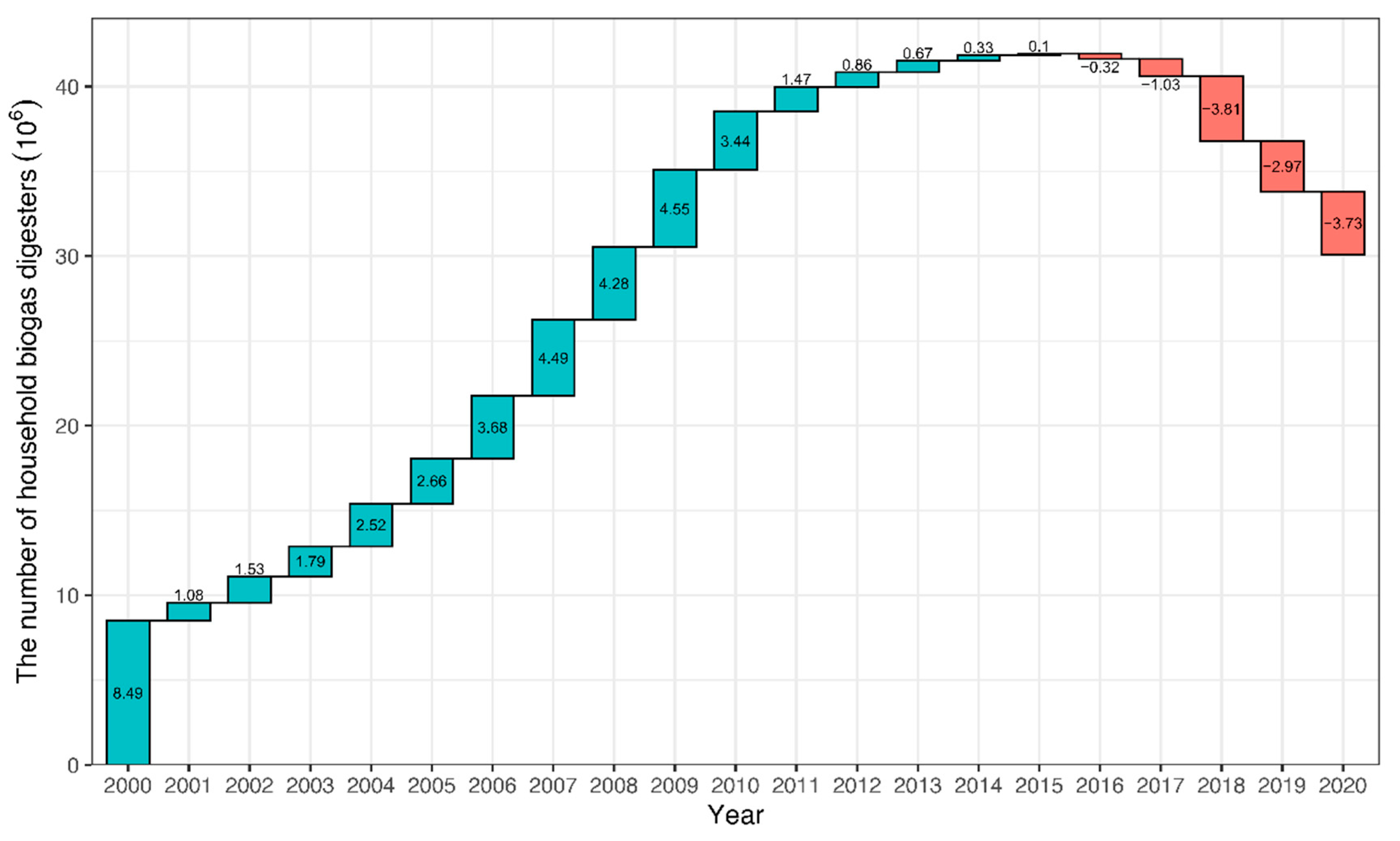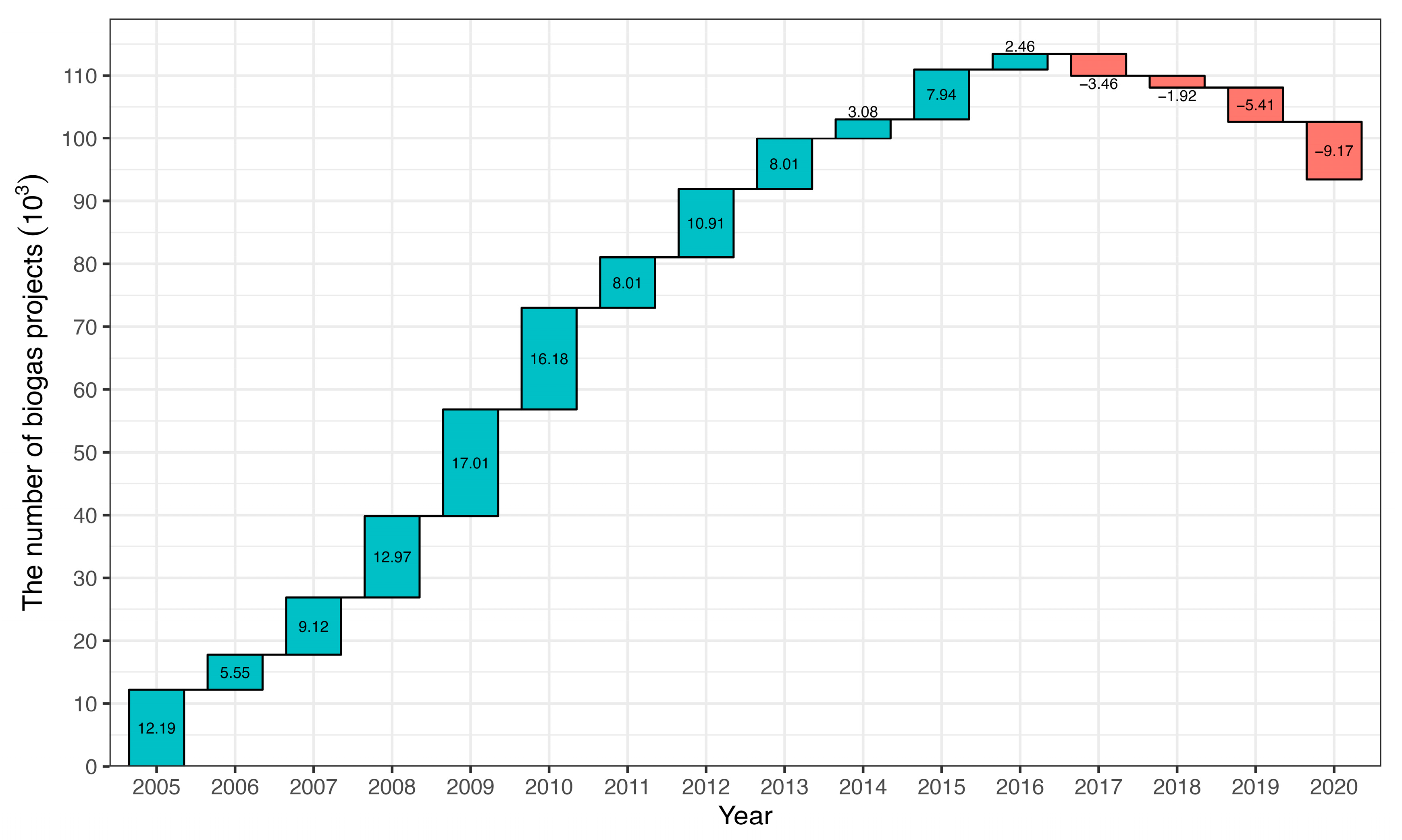China’s Biogas Industry’s Sustainable Transition to a Low-Carbon Plan—A Socio-Technical Perspective
Abstract
:1. Introduction
2. Methodology
2.1. SNM
2.2. Typology of Transition Pathways
- (a)
- Reproduction process: Without pressure from the landscape, whilst niche innovation possibilities remain, the chances of breakthroughs are narrow. With an absence of real interaction between landscape, regimes, and niche, the socio-technical systems are in a state of self-replication.
- (b)
- Transformation path: When the landscape is more moderate and niche innovations are not adequately developed to exploit the opportunities offered by landscape pressures, actors within the existing regime will redirect their developmental paths and innovation activities to cope with the pressure.
- (c)
- Reconfiguration path: A set of interdependent innovations developed from the niche begin to be used in the regime, replacing the former technology portfolio to solve local problems, which subsequently triggers the restructuring of the underlying regime.
- (d)
- Technological substitution: Disruptive changes at the landscape level that destabilize existing regimes, creating windows of opportunity for niche innovations to break through the resistance to existing regimes and create new ones to replace them.
- (e)
- De-alignment and re-alignment path: Multiple dramatic sudden changes occur in the landscape, increasing the regime problems and leading to a loss of confidence among internal actors. The regime splits and gradually weakens without significant technological substitution, as at the beginning of the split, the niche innovations are not yet well developed. However, this scenario will provide scope for the further development of multiple co-existing and competing niche innovations.
3. Niche and Sustainable Models
3.1. Niches as Units of Sustainable Transition
3.1.1. Definition of Niche: Functionality of Anaerobic Digestion in China
3.1.2. Regime Pressures and Challenges for Each Mono-Function of Biogas in China
- A.
- Waste Management
- B.
- Nutrient Recycling
- C.
- Energy Recovery
- D.
- Climate Benefits
3.2. Sustainable Multi-Functional Models
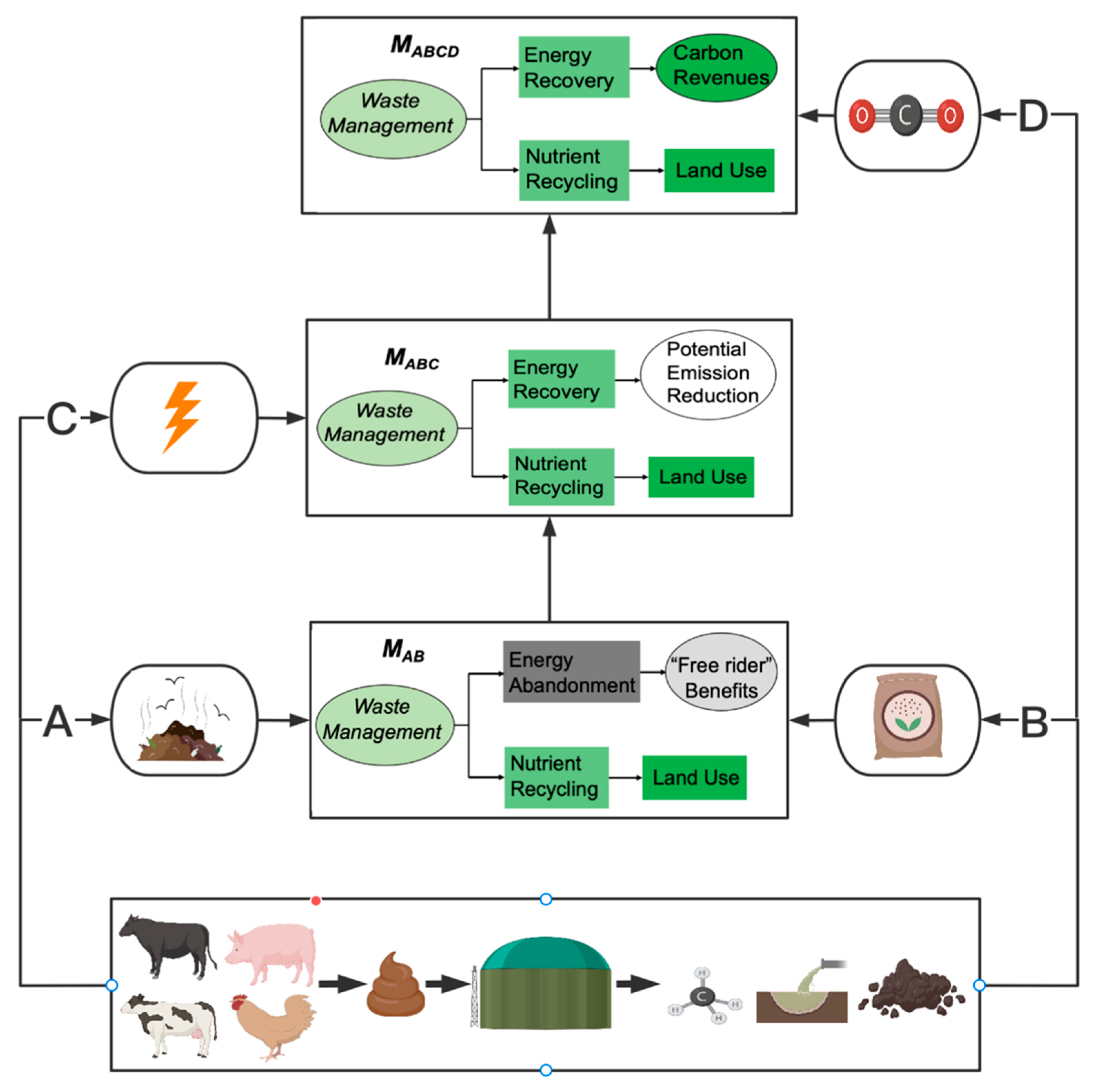
4. Scenarios of Various Biogas Transition Pathways
4.1. Defining Chinese Biogas Transition Pathways Based on Biogas Development Scenarios in China
- (a)
- Chinese biogas industry reproduction process
- (b)
- Chinese biogas industry transformation path
- (c)
- Chinese biogas industry reconfiguration path
- (d)
- Chinese biogas industry technological substitution
- (e)
- Chinese biogas industry de-alignment and re-alignment path
| Chinese Biogas Transition Pathways | Highlights |
|---|---|
| Reproduction process | Abandoned the biogas sector |
| Transformation path | Incremental innovation strategy |
| Reconfiguration path | Radical innovation strategy |
| Technological substitution | Disruptive changes |
| De-alignment and re-alignment path | Focus on mono-functional properties |
4.2. China’s Biogas Transition Pathway before Carbon Peak (Now~2030)
4.2.1. Radical Innovation Scenario (Now~2030)
4.2.2. Incremental Innovation Scenario (Now~2030)
4.2.3. Differences in Emission Reduction and Economy under Different Strategies (Now~2030)
4.3. China’s Biogas Transition Pathway before Carbon Neutrality (2030~2060)
5. Discussion
5.1. The Importance of Biogas Niche Experiments and Expectations
5.1.1. Can China Manage without Biogas Technology? From Niche Experiments
5.1.2. Expectation of Investment in Energy Recovery Should Be Abandoned
5.1.3. Establish Expectations for Multi-Functional Biogas Technology
- (a)
- Big Cycle: Regional organic waste centralized treatment to produce biogas, bio-natural gas projects
- (b)
- Medium Cycle: Agri-park-style “breeding–biogas–planting” projects
- (c)
- Small Cycle: farm-style biogas projects
5.2. Insights from the Biogas Industry Transition Pathway
5.2.1. Transition Takes Time and Trust
5.2.2. Incremental Is Better Than Radical Innovation
5.2.3. Consistent Political Support Is a Guarantee for Transition
5.3. Implications of China’s Sustainable Biogas Transition for Basic Research
6. Conclusions
Supplementary Materials
Author Contributions
Funding
Data Availability Statement
Conflicts of Interest
Abbreviations
References
- Geels, F.W.; Sovacool, B.K.; Schwanen, T.; Sorrell, S. Sociotechnical transitions for deep decarbonization. Science 2017, 357, 1242–1244. [Google Scholar] [CrossRef] [PubMed]
- Geels, F.W.; Sovacool, B.K.; Schwanen, T.; Sorrell, S. The Socio-Technical Dynamics of Low-Carbon Transitions. Joule 2017, 1, 463–479. [Google Scholar] [CrossRef] [Green Version]
- Zhao, X.; Ma, X.; Chen, B.; Shang, Y.; Song, M. Challenges toward carbon neutrality in China: Strategies and countermeasures. Resour. Conserv. Recycl. 2021, 176, 105959. [Google Scholar] [CrossRef]
- Li, J.; Ho, M.S.; Xie, C.; Stern, N. China’s flexibility challenge in achieving carbon neutrality by 2060. Renew. Sustain. Energy Rev. 2022, 158, 112112. [Google Scholar] [CrossRef]
- Mallapaty, S. How China could be carbon neutral by mid-century. Nature 2020, 586, 482–483. [Google Scholar] [CrossRef]
- Olabi, A.G.; Abdelkareem, M.A. Renewable energy and climate change. Renew. Sustain. Energy Rev. 2022, 158, 112111. [Google Scholar] [CrossRef]
- Zhang, S.; Chen, W. Assessing the energy transition in China towards carbon neutrality with a probabilistic framework. Nat. Commun. 2022, 13, 1–15. [Google Scholar] [CrossRef]
- Markard, J.; Wirth, S.; Truffer, B. Institutional dynamics and technology legitimacy—A framework and a case study on bio-gas technology. Res. Policy 2016, 45, 330–344. [Google Scholar] [CrossRef]
- Mao, C.; Feng, Y.; Wang, X.; Ren, G. Review on research achievements of biogas from anaerobic digestion. Renew. Sustain. Energy Rev. 2015, 45, 540–555. [Google Scholar] [CrossRef]
- Song, Z.; Zhang, C.; Yang, G.; Feng, Y.; Ren, G.; Han, X. Comparison of biogas development from households and medium and large-scale biogas plants in rural China. Renew. Sustain. Energy Rev. 2014, 33, 204–213. [Google Scholar] [CrossRef]
- Duarah, P.; Haldar, D.; Patel, A.K.; Dong, C.-D.; Singhania, R.R.; Purkait, M.K. A review on global perspectives of sustainable development in bioenergy generation. Bioresour. Technol. 2022, 348, 126791. [Google Scholar] [CrossRef]
- Winquist, E.; Rikkonen, P.; Pyysiäinen, J.; Varho, V. Is biogas an energy or a sustainability product?—Business opportunities in the Finnish biogas branch. J. Clean. Prod. 2019, 233, 1344–1354. [Google Scholar] [CrossRef]
- Wang, X.; Lu, X.; Yang, G.; Feng, Y.; Ren, G.; Han, X. Development process and probable future transformations of rural biogas in China. Renew. Sustain. Energy Rev. 2016, 55, 703–712. [Google Scholar] [CrossRef]
- Feng, Y.; Guo, Y.; Yang, G.; Qin, X.; Song, Z. Household biogas development in rural China: On policy support and other macro sustainable conditions. Renew. Sustain. Energy Rev. 2012, 16, 5617–5624. [Google Scholar] [CrossRef]
- Chen, Y.; Hu, W.; Feng, Y.; Sweeney, S. Status and prospects of rural biogas development in China. Renew. Sustain. Energy Rev. 2014, 39, 679–685. [Google Scholar] [CrossRef]
- Lu, J.; Gao, X. Biogas: Potential, challenges, and perspectives in a changing China. Biomass Bioenergy 2021, 150, 106127. [Google Scholar] [CrossRef]
- Chen, Y.; Yang, G.; Sweeney, S.; Feng, Y. Household biogas use in rural China: A study of opportunities and constraints. Renew. Sustain. Energy Rev. 2010, 14, 545–549. [Google Scholar] [CrossRef]
- Yin, D.; Liu, W.; Zhai, N.; Wang, Y.; Ren, C.; Yang, G. Regional differentiation of rural household biogas development and related driving factors in China. Renew. Sustain. Energy Rev. 2017, 67, 1008–1018. [Google Scholar] [CrossRef]
- Zhang, X.; Brandt, M.; Tong, X.; Ciais, P.; Yue, Y.; Xiao, X.; Zhang, W.; Wang, K.; Fensholt, R. A large but transient carbon sink from urbanization and rural depopulation in China. Nat. Sustain. 2022, 5, 321–328. [Google Scholar] [CrossRef]
- Jia, X.; Du, H.; Zou, H.; He, G. Assessing the effectiveness of China’s net-metering subsidies for household distributed photovoltaic systems. J. Clean. Prod. 2020, 262, 121161. [Google Scholar] [CrossRef]
- Sun, R.; Yang, M.; Su, J.; Du, S.; Li, P.; Zheng, Y. Current situation of rural energy development and its development and utilization modes in China. J. China Agric. Univ. 2020, 25, 163–173. [Google Scholar]
- Liao, C.; Fei, D. Poverty reduction through photovoltaic-based development intervention in China: Potentials and constraints. World Dev. 2019, 122, 1–10. [Google Scholar] [CrossRef]
- Wu, S. The evolution of rural energy policies in China: A review. Renew. Sustain. Energy Rev. 2019, 119, 109584. [Google Scholar] [CrossRef]
- Gu, L.; Zhang, Y.-X.; Wang, J.-Z.; Chen, G.; Battye, H. Where is the future of China’s biogas? Review, forecast, and policy im-plications. Pet. Sci. 2016, 13, 604–624. [Google Scholar] [CrossRef] [Green Version]
- Deng, L.; Liu, Y.; Zheng, D.; Wang, L.; Pu, X.; Song, L.; Wang, Z.; Lei, Y.; Chen, Z.; Long, Y. Application and development of bio-gas technology for the treatment of waste in China. Renew. Sustain. Energy Rev. 2017, 70, 845–851. [Google Scholar] [CrossRef]
- Luo, T.; Khoshnevisan, B.; Huang, R.; Chen, Q.; Mei, Z.; Pan, J.; Liu, H. Analysis of revolution in decentralized biogas facilities caused by transition in Chinese rural areas. Renew. Sustain. Energy Rev. 2020, 133, 110133. [Google Scholar] [CrossRef]
- Jiang, X.; Sommer, S.G.; Christensen, K.V. A review of the biogas industry in China. Energy Policy 2011, 39, 6073–6081. [Google Scholar] [CrossRef]
- Gao, M.; Wang, D.; Wang, H.; Wang, X.; Feng, Y. Biogas potential, utilization and countermeasures in agricultural provinces: A case study of biogas development in Henan Province, China. Renew. Sustain. Energy Rev. 2018, 99, 191–200. [Google Scholar] [CrossRef]
- Deng, Y.; Xu, J.; Liu, Y.; Mancl, K. Biogas as a sustainable energy source in China: Regional development strategy application and decision making. Renew. Sustain. Energy Rev. 2014, 35, 294–303. [Google Scholar] [CrossRef]
- Walker, B.; Barrett, S.; Polasky, S.; Galaz, V.; Folke, C.; Engström, G.; Ackerman, F.; Arrow, K.; Carpenter, S.; Chopra, K.; et al. Looming Glob-al-Scale Failures and Missing Institutions. Science 2009, 325, 1345–1346. [Google Scholar] [CrossRef]
- Ministry of Agriculture (MOA). China Agriculture Statistical Report 2005–2017; China Agriculture Press: Beijing, China, 2017.
- Ministry of Agriculture (MOA). China Agriculture Statistical Report 2000–2004; China Agriculture Press: Beijing, China, 2004.
- National Bureau of statistics of the People’s Republic of China. China Rural Statistical Yearbook 2019–2021; China Statistical Press: Beijing, China, 2021.
- Xue, S.; Zhang, S.; Wang, Y.; Wang, Y.; Song, J.; Lyu, X.; Wang, X.; Yang, G. What can we learn from the experience of European countries in biomethane industry: Taking China as an example? Renew. Sustain. Energy Rev. 2022, 157, 112049. [Google Scholar] [CrossRef]
- Raven, R.P.J.M.; Gregersen, K.H. Biogas plants in Denmark: Successes and setbacks. Renew. Sustain. Energy Rev. 2007, 11, 116–132. [Google Scholar] [CrossRef]
- Rikkonen, P.; Tapio, P.; Rintamäki, H. Visions for small-scale renewable energy production on Finnish farms—A Delphi study on the opportunities for new business. Energy Policy 2019, 129, 939–948. [Google Scholar] [CrossRef]
- Scarlat, N.; Dallemand, J.-F.; Fahl, F. Biogas: Developments and perspectives in Europe. Renew. Energy 2018, 129, 457–472. [Google Scholar] [CrossRef]
- Li, J.M.; Xu, W.Y.; Li, B.; Zhang, D.L. The development dilemma and way out of China’s biogas industry, Renew. Energy Resour. 2020, 38, 1563–1568. [Google Scholar]
- Giwa, A.S.; Ali, N.; Ahmad, I.; Asif, M.; Guo, R.-B.; Li, F.-L.; Lu, M. Prospects of China’s biogas: Fundamentals, challenges and considerations. Energy Rep. 2020, 6, 2973–2987. [Google Scholar] [CrossRef]
- Zheng, L.; Cheng, S.; Han, Y.; Wang, M.; Xiang, Y.; Guo, J.; Cai, D.; Mang, H.-P.; Dong, T.; Li, Z.; et al. Bio-natural gas industry in China: Current status and development. Renew. Sustain. Energy Rev. 2020, 128, 109925. [Google Scholar] [CrossRef]
- Gu, B. Recoupling livestock and crops. Nat. Food 2022, 3, 102–103. [Google Scholar] [CrossRef]
- Jin, S.; Zhang, B.; Wu, B.; Han, D.; Hu, Y.; Ren, C.; Zhang, C.; Wei, X.; Wu, Y.; Mol, A.P.J.; et al. Decoupling live-stock and crop production at the household level in China. Nat. Sustain. 2021, 4, 48–55. [Google Scholar] [CrossRef]
- Xue, S.; Song, J.; Wang, X.; Shang, Z.; Sheng, C.; Li, C.; Zhu, Y.; Liu, J. A systematic comparison of biogas development and related policies between China and Europe and corresponding insights. Renew. Sustain. Energy Rev. 2020, 117, 109474. [Google Scholar] [CrossRef]
- Kasinath, A.; Fudala-Ksiazek, S.; Szopinska, M.; Bylinski, H.; Artichowicz, W.; Remiszewska-Skwarek, A.; Luczkiewicz, A. Bio-mass in biogas production: Pretreatment and codigestion. Renew. Sustain. Energy Rev. 2021, 150, 111509. [Google Scholar] [CrossRef]
- Sutherland, L.-A.; Peter, S.; Zagata, L. Conceptualising multi-regime interactions: The role of the agriculture sector in re-newable energy transitions. Res. Policy 2015, 44, 1543–1554. [Google Scholar] [CrossRef] [Green Version]
- Khan, M.U.; Lee, J.T.E.; Bashir, M.A.; Dissanayake, P.D.; Ok, Y.S.; Tong, Y.W.; Shariati, M.A.; Wu, S.; Ahring, B.K. Current status of biogas upgrading for direct biomethane use: A review. Renew. Sustain. Energy Rev. 2021, 149, 111343. [Google Scholar] [CrossRef]
- Li, Y.; Yan, B.; Qin, Y.; Shi, W.; Yan, J. Analysis of the types of animal husbandry and planting that influence household biogas in rural China. J. Clean. Prod. 2022, 332, 130025. [Google Scholar] [CrossRef]
- Song, J.; Wang, Y.; Zhang, S.; Song, Y.; Xue, S.; Liu, L.; Lvy, X.; Wang, X.; Yang, G. Coupling biochar with anaerobic digestion in a circular economy perspective: A promising way to promote sustainable energy, environment and agriculture development in China. Renew. Sustain. Energy Rev. 2021, 144, 110973. [Google Scholar] [CrossRef]
- Wang, W.; Zhang, Y.; Liu, Y.; Jiang, N.; Zhao, Q.; Deng, L. Managing liquid digestate to support the sustainable biogas industry in China: Maximizing biogas-linked agro-ecosystem balance. GCB Bioenergy 2021, 13, 880–892. [Google Scholar] [CrossRef]
- Zhu, T.; Curtis, J.; Clancy, M. Promoting agricultural biogas and biomethane production: Lessons from cross-country studies. Renew. Sustain. Energy Rev. 2019, 114, 109332. [Google Scholar] [CrossRef]
- Gao, M.; Wang, D.; Wang, Y.; Wang, X.; Feng, Y. Opportunities and Challenges for Biogas Development: A Review in 2013–2018. Curr. Pollut. Rep. 2019, 5, 25–35. [Google Scholar] [CrossRef]
- Nevzorova, T.; Kutcherov, V. Barriers to the wider implementation of biogas as a source of energy: A state-of-the-art review. Energy Strat. Rev. 2019, 26, 100414. [Google Scholar] [CrossRef]
- Hewitt, J.; Holden, M.; Robinson, B.L.; Jewitt, S.; Clifford, M.J. Not quite cooking on gas: Understanding biogas plant failure and abandonment in Northern Tanzania. Renew. Sustain. Energy Rev. 2022, 165, 112600. [Google Scholar] [CrossRef]
- Ministry of Agriculture (MOA). China Rural Energy Yearbook (2014–2022); China Agriculture Press: Beijing, China, 2022.
- van der Laak, W.W.M.; Raven, R.P.J.M.; Verbong, G.P.J. Strategic niche management for biofuels: Analysing past experiments for developing new biofuel policies. Energy Policy 2007, 35, 3213–3225. [Google Scholar] [CrossRef]
- Geels, F.W.; Kern, F.; Fuchs, G.; Hinderer, N.; Kungl, G.; Mylan, J.; Neukirch, M.; Wassermann, S. The enactment of socio-technical transition pathways: A reformulated typology and a comparative multi-level analysis of the German and UK low-carbon electricity transitions (1990–2014). Res. Policy 2016, 45, 896–913. [Google Scholar] [CrossRef]
- Verbong, G.P.J.; Geels, F.W. Exploring sustainability transitions in the electricity sector with socio-technical pathways. Technol. Forecast. Soc. Chang. 2010, 77, 1214–1221. [Google Scholar] [CrossRef]
- Geels, F.W. The dynamics of transitions in socio-technical systems: A multi-level analysis of the transition pathway from horse-drawn carriages to automobiles (1860–1930). Technol. Anal. Strateg. 2005, 17, 445–476. [Google Scholar] [CrossRef]
- Verburg, R.W.; Verberne, E.; Negro, S.O. Accelerating the transition towards sustainable agriculture: The case of organic dairy farming in the Netherlands. Agric. Syst. 2022, 198, 103368. [Google Scholar] [CrossRef]
- Wu, Z.; Shao, Q.; Su, Y.; Zhang, D. A socio-technical transition path for new energy vehicles in China: A multi-level perspective. Technol. Forecast. Soc. 2021, 172, 121007. [Google Scholar] [CrossRef]
- Zhang, F.; Chung, C.K.L.; Lu, T.; Wu, F. The role of the local government in China’s urban sustainability transition: A case study of Wuxi's solar development. Cities 2021, 117, 103294. [Google Scholar] [CrossRef]
- Yang, J.; Zhang, W.; Zhao, D.; Zhao, C.; Yuan, J. What can China learn from the UK’s transition to a low-carbon power sector? A multi-level perspective. Resour. Conserv. Recycl. 2022, 179, 106127. [Google Scholar] [CrossRef]
- Geels, F.; Raven, R. Non-linearity and expectations in niche-development trajectories: Ups and downs in Dutch biogas development (1973–2003). Technol. Anal. Strateg. 2006, 18, 375–392. [Google Scholar] [CrossRef]
- Raven, R.P.J.M.; Geels, F.W. Socio-cognitive evolution in niche development: Comparative analysis of biogas development in Denmark and the Netherlands (1973–2004). Technovation 2010, 30, 87–99. [Google Scholar] [CrossRef]
- Geels, F.W.; Raven, R.P.J.M. Socio-cognitive evolution and co-evolution in competing technical trajectories: Biogas development in denmark (1970–2002). Int. J. Sust. Dev. World 2007, 14, 63–77. [Google Scholar] [CrossRef]
- Lazarevic, D.; Valve, H. Niche politics: Biogas, technological flexibility and the economisation of resource recovery. Environ. Innov. Soc. Transit. 2020, 35, 45–59. [Google Scholar] [CrossRef]
- Schot, J.; Geels, F.W. Strategic niche management and sustainable innovation journeys: Theory, findings, research agenda, and policy. Technol. Anal. Strat. Manag. 2008, 20, 537–554. [Google Scholar] [CrossRef]
- Raven, R.; Kern, F.; Verhees, B.; Smith, A. Niche construction and empowerment through socio-political work. A meta-analysis of six low-carbon technology cases. Environ. Innov. Soc. Transit. 2016, 18, 164–180. [Google Scholar] [CrossRef] [Green Version]
- Nill, J.; Kemp, R. Evolutionary approaches for sustainable innovation policies: From niche to paradigm? Res. Policy 2009, 38, 668–680. [Google Scholar] [CrossRef]
- Lyytimäki, J.; Assmuth, T.; Paloniemi, R.; Pyysiäinen, J.; Rantala, S.; Rikkonen, P.; Tapio, P.; Vainio, A.; Winquist, E. Two sides of biogas: Review of ten dichotomous argumentation lines of sustainable energy systems. Renew. Sustain. Energy Rev. 2021, 141, 110769. [Google Scholar] [CrossRef]
- Geels, F.W.; Schot, J. Typology of sociotechnical transition pathways. Res. Policy 2007, 36, 399–417. [Google Scholar] [CrossRef]
- Raven, R.P.J.M.; Heiskanen, E.; Lovio, R.; Hodson, M.; Brohmann, B. The Contribution of Local Experiments and Negotiation Processes to Field-Level Learning in Emerging (Niche) Technologies: Meta-Analysis of 27 New Energy Projects in Europe. Bull. Sci. Technol. Soc. 2008, 28, 464–477. [Google Scholar] [CrossRef] [Green Version]
- Raven, R. Strategic Niche Management for Biomass. Ph.D. Thesis, Technische Universiteit Eindhoven, Eindhoven, The Netherlands, 2005. [Google Scholar]
- van Merkerk, R.O.; Robinson, D.K. Characterizing the emergence of a technological field: Expectations, agendas and net-works in Lab-on-a-chip technologies. Technol. Anal. Strateg. 2006, 18, 411–428. [Google Scholar] [CrossRef]
- Huttunen, S.; Kivimaa, P.; Virkamäki, V. The need for policy coherence to trigger a transition to biogas production. Environ. Innov. Soc. Transit. 2014, 12, 14–30. [Google Scholar] [CrossRef]
- Lin, L.; Xu, F.; Ge, X.; Li, Y. Improving the sustainability of organic waste management practices in the food-energy-water nexus: A comparative review of anaerobic digestion and composting. Renew. Sustain. Energy Rev. 2018, 89, 151–167. [Google Scholar] [CrossRef]
- Peng, W.; Lü, F.; Hao, L.; Zhang, H.; Shao, L.; He, P. Digestate management for high-solid anaerobic digestion of organic wastes: A review. Bioresour. Technol. 2020, 297, 122485. [Google Scholar] [CrossRef] [PubMed]
- Brémond, U.; Bertrandias, A.; Steyer, J.-P.; Bernet, N.; Carrere, H. A vision of European biogas sector development towards 2030: Trends and challenges. J. Clean. Prod. 2021, 287, 125065. [Google Scholar] [CrossRef]
- Moioli, E.; Schildhauer, T. Eco-Techno-Economic Analysis of Methanol Production from Biogas and Power-to-X. Ind. Eng. Chem. Res. 2022, 61, 7335–7348. [Google Scholar] [CrossRef]
- Okolie, J.A.; Tabat, M.E.; Gunes, B.; Epelle, E.I.; Mukherjee, A.; Nanda, S.; Dalai, A.K. A techno-economic assessment of bio-methane and bioethanol production from crude glycerol through integrated hydrothermal gasification, syngas fermenta-tion and biomethanation. Energy Convers. Manag. X 2021, 12, 100131. [Google Scholar]
- Baena-Moreno, F.M.; Sebastia-Saez, D.; Wang, Q.; Reina, T.R. Is the production of biofuels and bio-chemicals always profitable? Co-production of biomethane and urea from biogas as case study. Energy Convers. Manag. 2020, 220, 113058. [Google Scholar] [CrossRef]
- Baena-Moreno, F.M.; Pastor-Pérez, L.; Zhang, Z.; Reina, T.R. Stepping towards a low-carbon economy. Formic acid from bio-gas as case of study. Appl. Energy 2020, 268, 115033. [Google Scholar] [CrossRef]
- González-Castaño, M.; Kour, M.H.; González-Arias, J.; Baena-Moreno, F.M.; Arellano-Garcia, H. Promoting bioeconomy routes: From food waste to green biomethane. A profitability analysis based on a real case study in eastern Germany. J. Environ. Manag. 2021, 300, 113788. [Google Scholar] [CrossRef]
- Ding, L.; Cheng, J.; Qiao, D.; Li, H.; Zhang, Z. Continuous co-generation of biohydrogen and biomethane through two-stage anaerobic digestion of hydrothermally pretreated food waste. Energy Convers. Manag. 2022, 268, 116000. [Google Scholar] [CrossRef]
- Moghaddam, E.A.; Ahlgren, S.; Nordberg, Å. Assessment of Novel Routes of Biomethane Utilization in a Life Cycle Perspective. Front. Bioeng. Biotechnol. 2016, 4, 89. [Google Scholar] [CrossRef] [PubMed] [Green Version]
- Bruun, S.; Jensen, L.S.; Vu, V.T.K.; Sommer, S. Small-scale household biogas digesters: An option for global warming mitigation or a potential climate bomb? Renew. Sustain. Energy Rev. 2014, 33, 736–741. [Google Scholar] [CrossRef]
- Ioannou-Ttofa, L.; Foteinis, S.; Moustafa, A.S.; Abdelsalam, E.; Samer, M.; Fatta-Kassinos, D. Life cycle assessment of household biogas production in Egypt: Influence of digester volume, biogas leakages, and digestate valorization as biofertilizer. J. Clean. Prod. 2020, 286, 125468. [Google Scholar] [CrossRef]
- Bogdanov, D.; Farfan, J.; Sadovskaia, K.; Aghahosseini, A.; Child, M.; Gulagi, A.; Oyewo, A.S.; de Souza Noel Simas Barbosa, L.; Breyer, C. Radical transformation pathway towards sustainable electricity via evolutionary steps. Nat. Commun. 2019, 10, 1–16. [Google Scholar] [CrossRef] [Green Version]
- International Energy Agency (IEA). World Energy Outlook 2021; International Energy Agency (IEA): Paris, France, 2021. [Google Scholar]
- Tabatabaei, M.; Aghbashlo, M.; Valijanian, E.; Panahi, H.K.S.; Nizami, A.-S.; Ghanavati, H.; Sulaiman, A.; Mirmohamadsadeghi, S.; Karimi, K. A comprehensive review on recent biological innovations to improve biogas production, Part 2: Mainstream and downstream strategies. Renew. Energy 2020, 146, 1392–1407. [Google Scholar] [CrossRef]
- Tabatabaei, M.; Aghbashlo, M.; Valijanian, E.; Panahi, H.K.S.; Nizami, A.-S.; Ghanavati, H.; Sulaiman, A.; Mirmohamadsadeghi, S.; Karimi, K. A comprehensive review on recent biological innovations to improve biogas production, Part 1: Upstream strategies. Renew. Energy 2020, 146, 1204–1220. [Google Scholar] [CrossRef]
- Wang, C.; Zhang, Y.; Zhang, L.; Pang, M. Alternative policies to subsidize rural household biogas digesters. Energy Policy 2016, 93, 187–195. [Google Scholar] [CrossRef]
- Srinivasan, S. Positive externalities of domestic biogas initiatives: Implications for financing. Renew. Sustain. Energy Rev. 2008, 12, 1476–1484. [Google Scholar] [CrossRef]
- Furmankiewicz, M.; Hewitt, R.J.; Kazak, J.K. Can rural stakeholders drive the low-carbon transition? Analysis of cli-mate-related activities planned in local development strategies in Poland. Renew. Sustain. Energy Rev. 2021, 150, 111419. [Google Scholar] [CrossRef]
- Cui, R.Y.; Hultman, N.; Cui, D.; McJeon, H.; Yu, S.; Edwards, M.R.; Sen, A.; Song, K.; Bowman, C.; Clarke, L.; et al. A plant-by-plant strategy for high-ambition coal power phaseout in China. Nat. Commun. 2021, 12, 1–10. [Google Scholar] [CrossRef]
- Li, J.; Huang, J. The expansion of China's solar energy: Challenges and policy options. Renew. Sustain. Energy Rev. 2020, 132, 110002. [Google Scholar] [CrossRef]
- Leirpoll, M.E.; Næss, J.S.; Cavalett, O.; Dorber, M.; Hu, X.; Cherubini, F. Optimal combination of bioenergy and solar photo-voltaic for renewable energy production on abandoned cropland. Renew Energy 2021, 168, 45–56. [Google Scholar] [CrossRef]
- National Energy Administration (NEA). National Energy Administration Released January–June National Electricity Industry Statistics; National Energy Administration (NEA): Beijing, China, 2022. (In Chinese)
- Chinese Central Government. Opinions of the Central Committee of the CPC and the State Council on Carbon Dioxide Peaking and Carbon Neutrality in Full and Faithful Implementation of the New Development Philosophy; Chinese Central Government: Beijing, China, 2021. (In Chinese)
- Sovacool, B.K. How long will it take? Conceptualizing the temporal dynamics of energy transitions. Energy Res. Soc. Sci. 2016, 13, 202–215. [Google Scholar] [CrossRef] [Green Version]
- Mylan, J.; Geels, F.W.; Gee, S.; McMeekin, A.; Foster, C. Eco-innovation and retailers in milk, beef and bread chains: Enriching environmental supply chain management with insights from innovation studies. J. Clean. Prod. 2014, 107, 20–30. [Google Scholar] [CrossRef]
- Kramer, G.J.; Haigh, M. No quick switch to low-carbon energy. Nature 2009, 462, 568–569. [Google Scholar] [CrossRef] [PubMed]
- Fouquet, R.; Pearson, P.J.G. Past and prospective energy transitions: Insights from history. Energy Policy 2012, 50, 1–7. [Google Scholar] [CrossRef]
- Grubler, A. Energy transitions research: Insights and cautionary tales. Energy Policy 2012, 50, 8–16. [Google Scholar] [CrossRef]
- Deutch, J. Is Net Zero Carbon 2050 Possible? Joule 2020, 4, 2237–2240. [Google Scholar] [CrossRef]
- Hout, S.A. Momentum and Continuity. In Survival to Growth; Hout, S.A., Ed.; Palgrave Macmillan: New York, NY, USA, 2013; pp. 145–162. [Google Scholar]
- Malhotra, A.; Schmidt, T.S. Accelerating Low-Carbon Innovation. Joule 2020, 4, 2259–2267. [Google Scholar] [CrossRef]
- Venus, T.E.; Strauss, F.; Venus, T.J.; Sauer, J. Understanding stakeholder preferences for future biogas development in Ger-many. Land Use Policy 2021, 109, 105704. [Google Scholar] [CrossRef]
- International Energy Agency (IEA). World Energy Outlook 2011; International Energy Agency (IEA): Paris, France, 2011. [Google Scholar]
- Wang, X.; Chen, Y.; Sui, P.; Gao, W.; Qin, F.; Wu, X.; Xiong, J. Efficiency and sustainability analysis of biogas and electricity production from a large-scale biogas project in China: An emergy evaluation based on LCA. J. Clean. Prod. 2014, 65, 234–245. [Google Scholar] [CrossRef]
- Zhang, C.; Xu, Y. Economic analysis of large-scale farm biogas power generation system considering environmental bene-fits based on LCA: A case study in China. J. Clean. Prod. 2020, 258, 120985. [Google Scholar] [CrossRef]
- Lybæk, R.; Christensen, T.B.; Kjær, T. Governing Innovation for Sustainable Development in the Danish Biogas Sector—A Historical Overview and Analysis of Innovation. Sustain. Dev. 2013, 21, 171–182. [Google Scholar] [CrossRef]
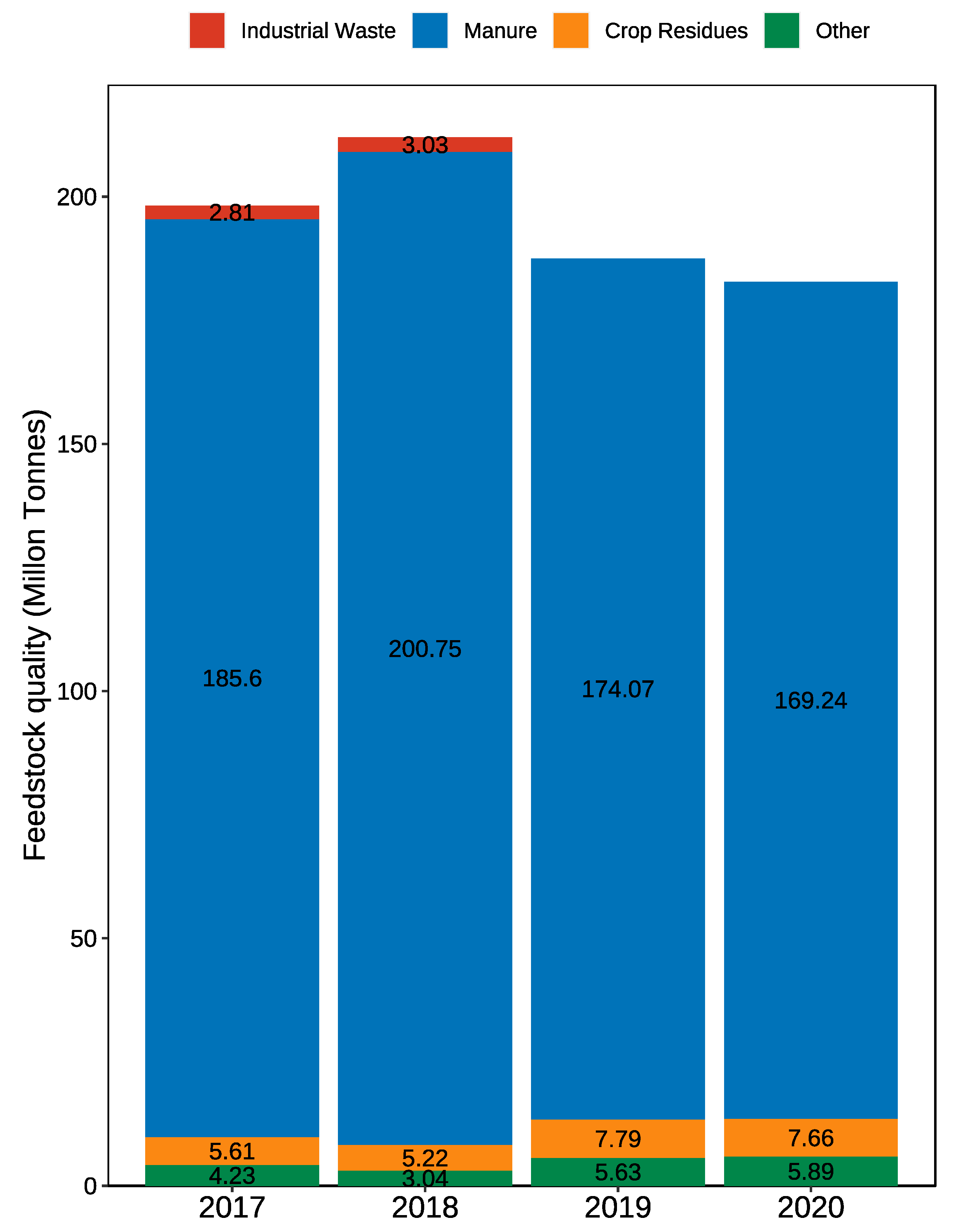
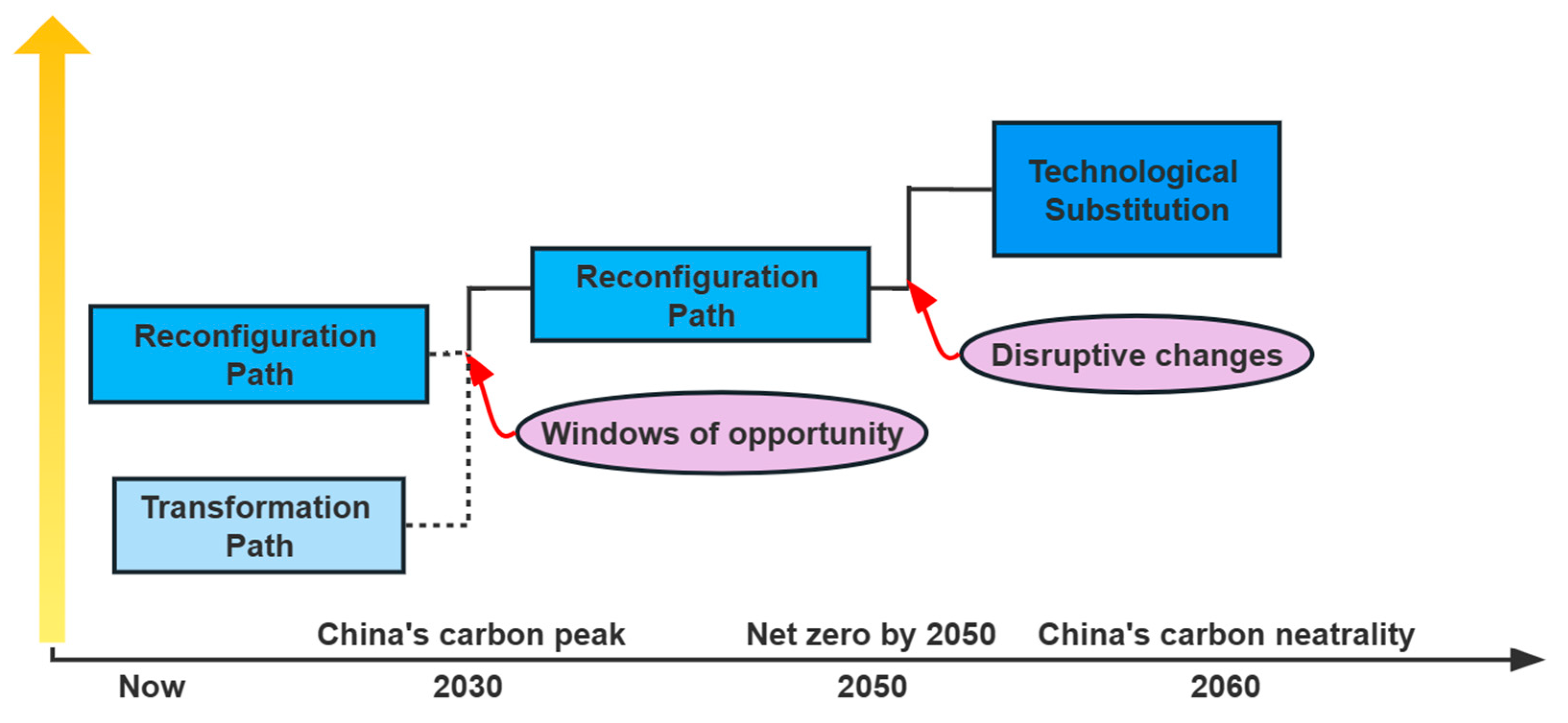
| Normative | Regulative | Cognitive | ||
|---|---|---|---|---|
| Mechanisms | Coercive | Normative pressure | Mimetic, learning, imitation | |
| Legitimacy | Legally sanctioned | Morally governed | Conceptually correct | |
| A | Waste Management | Compulsory environmental regulations Reasonable waste management subsidies | Waste management benefits NIMBY | Environmental recommendations |
| B | Nutrient Recycling | Agricultural compulsory demands Organic farming strongly driving | Benefits of organic farming | Agricultural recommendations |
| C | Energy Recovery | Renewable energy demand-driven | Benefits of alternative energy | Theoretical energy cost savings |
| D | Climate Benefit | Compulsory emission reduction credits Reasonable carbon price trading revenue | Pilot climate benefits | Theoretical emission reduction benefits |
| Scenario | Biogas Production (Billion m3) | Emission Reduction (Mt CO2e) | Required Subsidies (CNY Billion) |
|---|---|---|---|
| 2030 RS | 44.78 | 80 | 273.75 |
| 2030 RI | 53.82 | 96 | 335.66 |
| 2030 II | 4.78 | 9 | 23.21 |
Disclaimer/Publisher’s Note: The statements, opinions and data contained in all publications are solely those of the individual author(s) and contributor(s) and not of MDPI and/or the editor(s). MDPI and/or the editor(s) disclaim responsibility for any injury to people or property resulting from any ideas, methods, instructions or products referred to in the content. |
© 2023 by the authors. Licensee MDPI, Basel, Switzerland. This article is an open access article distributed under the terms and conditions of the Creative Commons Attribution (CC BY) license (https://creativecommons.org/licenses/by/4.0/).
Share and Cite
Wang, Y.; Zhi, B.; Xiang, S.; Ren, G.; Feng, Y.; Yang, G.; Wang, X. China’s Biogas Industry’s Sustainable Transition to a Low-Carbon Plan—A Socio-Technical Perspective. Sustainability 2023, 15, 5299. https://doi.org/10.3390/su15065299
Wang Y, Zhi B, Xiang S, Ren G, Feng Y, Yang G, Wang X. China’s Biogas Industry’s Sustainable Transition to a Low-Carbon Plan—A Socio-Technical Perspective. Sustainability. 2023; 15(6):5299. https://doi.org/10.3390/su15065299
Chicago/Turabian StyleWang, Yanbo, Boyao Zhi, Shumin Xiang, Guangxin Ren, Yongzhong Feng, Gaihe Yang, and Xiaojiao Wang. 2023. "China’s Biogas Industry’s Sustainable Transition to a Low-Carbon Plan—A Socio-Technical Perspective" Sustainability 15, no. 6: 5299. https://doi.org/10.3390/su15065299





